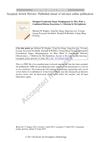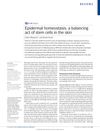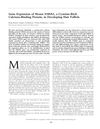TLDR HDAC1 is crucial for skin development and preventing tumors.
The study investigated the roles of HDAC1 and HDAC2 in epidermal development and tumorigenesis by manipulating their expression in mice. It was found that while the deletion of either HDAC1 or HDAC2 alone did not result in noticeable changes, the loss of a single Hdac2 allele in HDAC1 knockout mice led to severe epidermal defects, including alopecia, hyperkeratosis, hyperproliferation, and spontaneous tumor formation. These defects were linked to impaired Sin3A co-repressor complex function, increased c-Myc protein levels, p53 expression, and apoptosis in hair follicles. HDAC1 ablation, but not HDAC2, accelerated tumor development, highlighting HDAC1's role as a tumor suppressor in the epidermis. The study concluded that HDAC1 and HDAC2 have partially redundant functions, with HDAC1 playing a more critical role in epidermal development and tumor suppression.
 32 citations
,
June 2013 in “Journal of Investigative Dermatology”
32 citations
,
June 2013 in “Journal of Investigative Dermatology” Mice without certain skin proteins had abnormal skin and hair development.
 354 citations
,
February 2011 in “Genes & Development”
354 citations
,
February 2011 in “Genes & Development” EZH1 and EZH2 are crucial for healthy hair growth and skin repair.
 1039 citations
,
February 2009 in “Nature Reviews Molecular Cell Biology”
1039 citations
,
February 2009 in “Nature Reviews Molecular Cell Biology” Skin stem cells are crucial for maintaining and repairing the skin and hair, using a complex mix of signals to do so.
1279 citations
,
November 2005 in “Nature Medicine” 182 citations
,
May 2003 in “Development” Myc activation reduces skin stem cells by affecting cell adhesion.
315 citations
,
June 2001 in “Nature Genetics” 338 citations
,
April 2001 in “Current Biology” c-Myc activation in mouse skin increases sebaceous gland growth and affects hair follicle development.
 40 citations
,
November 1998 in “The journal of investigative dermatology/Journal of investigative dermatology”
40 citations
,
November 1998 in “The journal of investigative dermatology/Journal of investigative dermatology” S100A3 protein is crucial for hair shaft formation in mice.
 5 citations
,
December 2021 in “Frontiers in Cell and Developmental Biology”
5 citations
,
December 2021 in “Frontiers in Cell and Developmental Biology” Enzymes called PADIs play a key role in hair growth and loss.
 179 citations
,
July 2016 in “Nature Reviews Molecular Cell Biology”
179 citations
,
July 2016 in “Nature Reviews Molecular Cell Biology” Epigenetic changes control how adult stem cells work and can lead to diseases like cancer if they go wrong.
 32 citations
,
June 2013 in “Journal of Investigative Dermatology”
32 citations
,
June 2013 in “Journal of Investigative Dermatology” Mice without certain skin proteins had abnormal skin and hair development.
 January 2018 in “Stem cell biology and regenerative medicine”
January 2018 in “Stem cell biology and regenerative medicine” The conclusion is that the nuclear lamina and LINC complex in skin cells respond to mechanical signals, affecting gene expression and cell differentiation, which is important for skin health and can impact skin diseases.
 4 citations
,
January 2013 in “Advances in Experimental Medicine and Biology”
4 citations
,
January 2013 in “Advances in Experimental Medicine and Biology” Certain transcription factors are key in controlling skin stem cell behavior and could impact future treatments for skin repair and hair loss.







